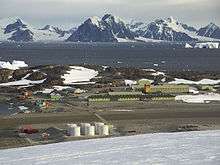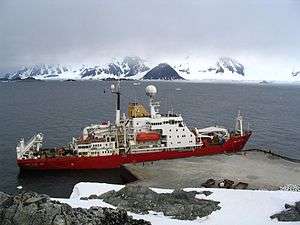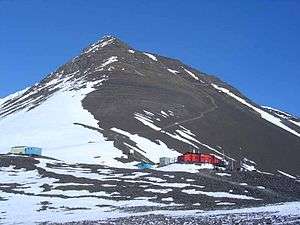Symphony No. 8 (Davies)
The Symphony No. 8 (also called the Antarctic Symphony) is an orchestral composition by Peter Maxwell Davies, completed on 15 December 2001.
| Symphony No. 8 | |
|---|---|
| Antarctic Symphony | |
| by Peter Maxwell Davies | |
 Rothera Research Station (BAS main centre for fieldwork) where Davies was based during his visit to Antarctica | |
| Premiere | |
| Date | 10 May 2001 |
| Location | Royal Festival Hall |
| Conductor | Peter Maxwell Davies |
| Performers | Philharmonia Orchestra |
History
Davies had announced prior to its premiere that his Seventh Symphony was to be his last work in the form (Service 2000). Less than six months later, Davies amended his statement to say that it was only the last of a seven-symphony cycle: "No. 8, next year, will be a musical account of my visit to Antarctica, with very different aims and preoccupations" (Davies & [2000]). Advance publicity for the Eighth proved to be more than that for the other seven symphonies put together (Anon. 2001).

Three years earlier the British Antarctic Survey, which was seeking to promote the region's significance, had asked the Philharmonia Orchestra to recommend a composer for the commission of an orchestral work intended to commemorate the fiftieth anniversary of Ralph Vaughan Williams's score for the 1948 film Scott of the Antarctic and the Seventh Symphony (Sinfonia antartica) which he fashioned out of that film score. Davies, as a committed environmentalist, was chosen. Terms of the commission required the composer to visit Antarctica, which he did for three weeks from late December 1997 to January 1998 (Alberge 2001; Anon. 2001; Conway 2001; Witts 2001, 8). The composer published his diary of the trip as an illustrated book, Notes from a Cold Climate (Davies 2001b). The composer also revealed that the symphony reflects his experience of having heard Vaughan Williams's Seventh at its first performance in Manchester in 1953 (Alberge 2001; Conway 2001). In the end, Davies decided that his new work would also be a symphony.
Davies conducted the Philharmonia Orchestra in the premiere of his Antarctic Symphony at the Royal Festival Hall in London, on 6 May 2001 (Uppenbrink 2001). At this time, Davies once more announced that this would be absolutely his last symphony (Anon. 2001; Witts 2001, 8). This time it would take him ten years to change his mind.
Character and materials

Davies said he was "greatly influenced by my encounter with scientists searching into ways in which the Antarctic will change our environment over the coming centuries" (Alberge 2001). The sounds of two particular events in his polar journey were incorporated directly into the symphony. The BAS had flown the composer to the Falklands, but from there onward it was a sea voyage. In his journal, Davies described hearing "the ice crack and split before the bow, then roar along, keel to stern, in a tumultuous clatter of slabs and shards", and this sound is represented at the beginning of the symphony through the percussive use of a biscuit tin filled with broken glass, a tam-tam with plastic soapdish, and three lengths of builders' scaffolding. The second sound was of an avalanche as the ship passed through a narrow channel between ice mountains. The composer described the sound that suddenly enveloped the ship as "the mightiest, gentlest, longest whisper ever. It was a sound which seemed almost quieter than the silence which surrounded it" (Finch and Davies 2001). These two sounds, of an ice-break and an avalanche, suggested using a Pentecost plainsong associated with the descent of the Holy Spirit upon the Apostles, which Davies had used before: "Dum complerentur dies pentecostes erant omnes pariter dicentes: Alleluia. Et subito factus est sonus de coelo … Tamquam spiritus vehementis" (And when the day of Pentecost was fully come, they were all with one accord in one place saying: Alleluia. And suddenly there came a sound from heaven … as of a mighty rushing wind) (Davies & [2001a]).
Instrumentation
The symphony is scored for piccolo, two flutes, two oboes, cor anglais, two clarinets, bass clarinet, two bassoons, double bassoon, four horns, three trumpets, three trombones, tuba, timpani, five percussionists (xylophone with Japanese temple gong and 2 cymbals, glockenspiel, marimba, crotales, tubular bells, bell-tree, very small high wood-block, Chinese cymbals, clashed cymbals, 4 suspended cymbals (very small, small, medium, large), nipple gong, tam-tam (with plastic soap-dish), tuned brandy glasses (with water), 2 small pebbles, football rattle, biscuit tin (filled with broken glass), 3 lengths of metal builder's scaffolding (5 inches or 18 cm, 12 inches or 30 cm, 16 inches or 40 cm) to be hit by a mallet), harp, celeste, strings
Analysis
The symphony is in a single movement divided into five sections, reflecting the five movements of Vaughan Williams's Seventh (Witts 2001, 11). It is constructed symmetrically around a central scherzo, preceded and followed by slow sections, and faster music at the beginning and end (Anon. 2001). A brief introduction is followed by an allegro exposition featuring sharply contrasting dynamics. The first slow section begins with a simple clarinet melody accompanied by pizzicato cellos. Material from the introduction is then developed in a faster tempo, leading into the central scherzo which recalls Davies's An Orkney Wedding with Sunrise. This ends with an episode describing the litter left behind by early Antarctic expeditions, represented here by quotations from Davies's own recent works, followed by the second slow section, with glittering icy sounds overlaying earlier material. The final fast section transforms the ideas from the exposition, representing the changing shape of partially thawing icebergs in midsummer, and a slower coda brings back elements from the introduction (Conway 2001; Davies & [2001a]).
References
- Alberge, Dalya. 2001. "Lost Ice Shelf Inspired Composer". The Times (13 April): 10.
- Allison, John. 2004. "BBC PO/Maxwell Davies & Tortelier". The Times (8 June): 19.
- Anon. 2001. "Classical: Antarctic Symphony: Royal Festival Hall, London". The Guardian (7 May): 12.
- Conway, Paul. 2001. "Royal Festival Hall: Max's 'Antarctic' Symphony". Tempo, new series, no. 217 (July): 52.
- Davies, Peter Maxwell. [2000]. "Symphony No. 7: Composers Note". MaxOpus website. Accessed 3 January 2012).
- Davies, Peter Maxwell. [2001a]. "Antarctic Symphony (Symphony No. 8): Composer’s Note". MaxOpus website (Accessed 3 January 2012).
- Davies, Peter Maxwell. 2001b. Notes from a Cold Climate: Antarctic Symphony (Symphony No. 8). London: Browns. ISBN 0-9533730-3-7.
- Finch, Hilary, and Peter Maxwell Davies. 2001. "Silent Harmonies from the Ice Field" (20 April): 15.
- Morrison, Richard. 2005. "Philharmonia/Maxwell Davies. Festival Hall". The Times (4 May): 22.
- Service, Tom. 2000. "Music: Sea Power: Peter Maxwell Davies Has Just Premiered His Last Ever Symphony at His Annual Festival in the Orkney Islands. Tom Service Hears Music Full of Wild, Tidal Strength". The Guardian (23 June): 12.
- Uppenbrink, Julia. 2001. "Nota Bene: Sounds of Silence: Antarctic Symphony by Peter Maxwell Davies". Science, new series 292, no. 5524 (15 June): 2017.
- Witts, Richard. 2001. "Remastering the Past: 'Renewal' in Recent British Music". The Musical Times 142, no. 1876 (Autumn): 7–10.
External links
- Davies: Symphony No. 8 (Antarctic) (unidentified orchestra and conductor).